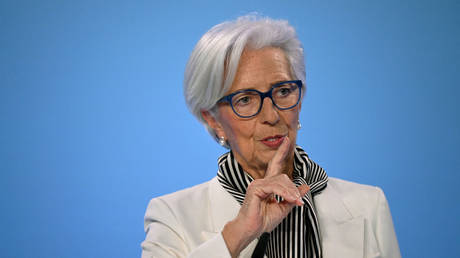Christine Lagarde’s New Vision for the ECB
by Claudio Grass, Mises Institute:
 On December 12, Christine Lagarde introduced her goals and vision in her first rate-setting meeting as the new president of the European Central Bank (ECB). On the actual policy front, there were no surprises. She remained committed to the path set by her predecessor, Mario Draghi, and kept the current monetary stimulus unchanged. The central bank kept its deposit rate at the present record-low –0.5 percent and pledged to continue its €20 billion bond purchases every month, to the chagrin of its many critics, who have repeatedly and loudly expressed serious concerns over the policy’s impact on the banking sector, on the insurance industry, and on everyday savers and pensioners. This was all widely expected, as the new president had so far only praised Draghi’s leadership and his “whatever it takes” campaign to save the eurozone and the euro.
On December 12, Christine Lagarde introduced her goals and vision in her first rate-setting meeting as the new president of the European Central Bank (ECB). On the actual policy front, there were no surprises. She remained committed to the path set by her predecessor, Mario Draghi, and kept the current monetary stimulus unchanged. The central bank kept its deposit rate at the present record-low –0.5 percent and pledged to continue its €20 billion bond purchases every month, to the chagrin of its many critics, who have repeatedly and loudly expressed serious concerns over the policy’s impact on the banking sector, on the insurance industry, and on everyday savers and pensioners. This was all widely expected, as the new president had so far only praised Draghi’s leadership and his “whatever it takes” campaign to save the eurozone and the euro.
However, what was a lot less expected was the vision and the outlook she shared on the future of the ECB and of the eurozone economy. At a time when the central bank is facing unprecedented internal divisions between hawks and doves, Lagarde highlighted that she is neither. Instead, she professed, her ambition is to be an “owl” and to be “associated with a little bit of wisdom.” As for her outlook on the bloc’s economy, Lagarde didn’t appear too worried, even though plenty of reasons for concern have emerged over the last year: Germany flirting with recession, Italian banks’ record-breaking debt levels, and political tensions threatening economic stability…It’s also worth remembering that France has basically spent the whole of 2019 paralyzed by nationwide protests, which have yet to dissipate. Also, after years of negative interest rates and over €2.6 trillion in asset purchases, the banking sector faces towering challenges to profitability, while insurances and pensions have also suffered. Nevertheless, the new ECB president still declared that “Europe’s economy is showing signs of stabilization,” with a growth forecast of 1.2 percent in 2019, an upgrade from an earlier projection of 1.1 percent.
Furthermore, Lagarde is also laser-focused on fiscal “solutions,” singling out budget surpluses as the enemy, following a worrying trend that we have examined in a previous article on the matter. Perhaps conscious of the fact the ECB is running out of ammunition to fight the next economic downturn, she has used strong language to urge the very few fiscally responsible countries, such as Germany and the Netherlands, to spend more, for the sake of “solidarity.”
A New Monetary Policy Approach
There is a very good reason for the idea of separation of powers between the politicians and central bankers. It’s been clear for a long time that allowing politics to influence monetary policy carries significant and numerous risks, as the incentives of politicians seeking reelection are naturally focused on short-term results and voter-pleasing policies. Monetary decisions are left wide open to abuse, leading to unsustainable policies and eventually setting the economy on a crash course.
It is important to bear these risks in mind when assessing the new policy direction of the ECB, especially since its new president, a lawyer with no previous central banking experience, comes from the political world. Lagarde’s vision for the central bank and her stated primary aims don’t include any concretely economic goals, nor do they revolve around traditional central banking considerations. Instead, she appears to be focused on healing the deep divides within the ECB and between eurozone member states, and on finding diplomatic solutions to move forward.
This, of course, is no easy task. In Germany alone, over 40 percent of the population distrusts the ECB according to the latest Eurobarometer survey. In Greece, a country Lagarde recently singled out for high praise for its “achievements” after many extremely painful years of large-scale economic strife, that figure rises to a staggering 71 percent. And although consensus building, bringing people together and overcoming rifts, surely is an important and noble pursuit, one would think that it wouldn’t really fall within the purview of a central bank president.
Loading...



